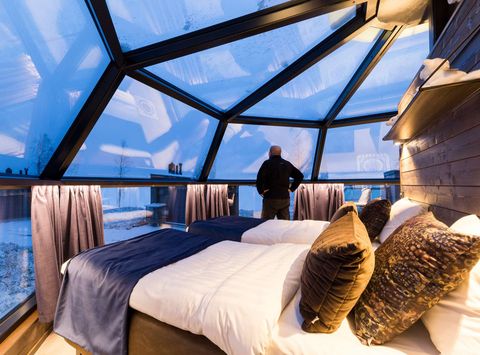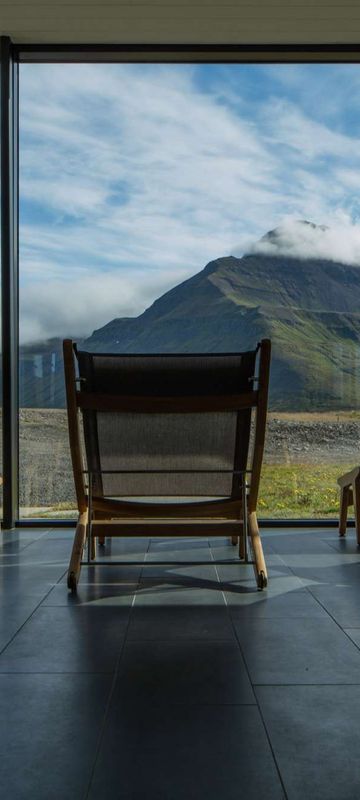The Nordics are a pretty special place. In fact, the spectacular scenery, magical ambiance and warm hospitality in Iceland, Sweden, Norway, Finland and Denmark is hard to beat. But there is something that can make a holiday there even more special: a unique, luxurious place to stay. Here are five of our favourite hotels in the Nordics that offer more than just a place to lay your head.
Arctic Fox Glass Igloo, Finland
Located on the shores of Lake Ranuanjärvi in beautiful snow-wreathed forest near the Arctic Circle, these ingenious igloos have been designed with the bedroom under a glass dome facing the northern sky for optimal aurora viewing. The glass is even heated to ensure no frost or snow interferes with your northern lights appreciation. Each igloo is equipped with a kitchenette, bathroom and private sauna, while two extra beds can be included for children. The ultimate out-of-this-world winter break.
Our travel specialist says
“Watching the aurora dance and keeping your toes warm are not mutually exclusive. With panoramic windows to the north, these amazing cabins are the best way to enjoy the northern lights and the night sky – maybe with a glass of something warming in hand!” Silvena, Nordic Product Specialist
Take me there
Combine an overnight stay in a glass igloo with a three-night break at the nearby Ranua Wildlife Park for the chance to spot native wildlife like wolves, moose, lynx and polar bears. Here’s more about our Aurora Glass Igloo and Ranua Wildlife Park trip, starting at £969 per person, including flights.
Deplar Farm, Iceland
If you want to experience the wilderness of Iceland but with a retreat back to luxury at the end of the day, look no further than a stay at Deplar Farm. Situated on the magnificent Troll Peninsula, the former sheep farm is one of the most isolated hotels in Europe, surrounded only by mountains and rolling land – which, of course, is part of its appeal.
The hotel’s black timber frame and living roof complement the beautiful natural landscape, while the 12 suites strike the perfect balance between comfort and style.
Adventuring is made easy, with many activities included in your booking — snow-shoeing, biking, whale watching and skiing are all on offer — and an experience manager is assigned to each guest for the duration of your stay. Skiers, take note: the area experiences some of the heaviest snowfall in the world and incredible heli-skiing is on offer between March and June.
Take me there
Create your own North Iceland adventure including a stay at Deplar Farm with our Iceland For Connoisseurs itinerary.
Treehotel, Sweden
Getting back to nature is quite literally what you’ll be doing with a stay at Swedish Lapland’s other-worldly Treehotel. The retreat’s seven rooms are all suspended several meters off the ground amongst the trees of a beautiful forest, taking treehouses to a whole new level
The views and tranquillity at Treehotel will convince you never to want to leave your treetop home from home. But the array of activities on offer, from snowshoeing and dog sledding in the winter to sea kayaking and horse riding in the summer, might just tempt you out. Alternatively, stay put and relax. A jacuzzi, spa, massage treatments and even a Tree sauna are all at your disposable.
Take me there
Our Brandon Lodge and Treehotel break combines staying at the Treehotel with the cosy cabins at Brandon Lodge, from £2,077 per person including flights.
Skalakot Manor, Iceland
Nestled between mountains and the ocean, this working family farm has an enviable location, with black-sand beaches to the south and the volcanic Highlands rearing to the north. Owners Gudmundur and Joóhanna have created luxurious, but homely, accommodation consisting of just 14 stylish rooms.
The cosy restaurant serves dishes inspired from local ingredients. We highly recommend lingering over a candlelit dinner of Arctic char fresh from the farm’s private fishing river.
A stay at Skalakot is fantastic no matter the season. Head there in winter to experience snowmobiling on nearby glaciers, while autumn and spring are your best bet for northern lights watching. During summer, you can join a magical summer night horse riding tour.
Our travel specialist says
“This hotel is like a home from home — I fell in love with the place! The décor is traditional but modern and the food was filling and amazing. In the evening, the lounge is the perfect place to relax with a glass of wine by the fire and talk about the day’s exploring.” Sally, Nordic Product Manager
Take me there
Two-night stays start at £340 per person, including breakfast. Find out more about the Skalakot Manor.
Arctic Bath, Sweden
Following much anticipation from the luxury travel community, the creators of Treehotel opened Arctic Bath at the end of 2019. The concept is extraordinary: a hotel situated on the Lule River near Harads in Swedish Lapland which freezes onto the water in winter and floats during summer.
The ultimate eco-hotel, it was constructed using local materials with minimal impact on the environment. Peace and quiet is the order of the day: only 12 cabins make up the hotel, six of which float serenely on the water, and all offer Scandi-chic interior and cosy underfloor heating.
The onus at Arctic Bath is firmly on well-being and relaxing amongst nature, which comes pretty easily, it has to be said. The open-air natural plunge pool and hot bath are a real treat, especially if you’re treated to the northern lights dancing overhead.
Take me there
A three-night spa break at Arctic Bath starts from £1923 per person, including flights.





























